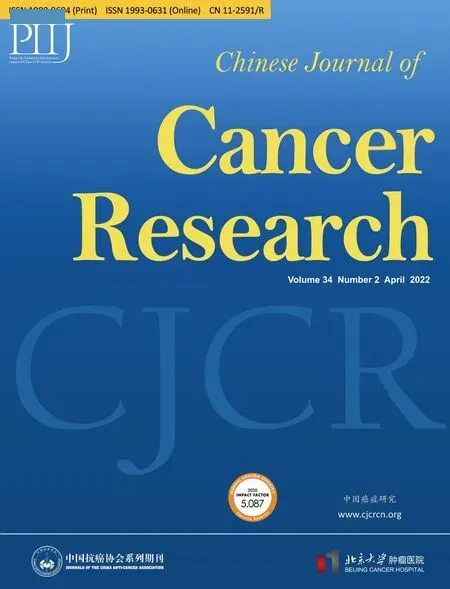Pan-cancer tumor-infiltrating T cells:A great hallmark in cancer immunology research
Anqiang Wang,Zhaode Bu
Key Laboratory of Carcinogenesis and Translational Research (Ministry of Education/Beijing),Center of Gastrointestinal Cancer,Peking University Cancer Hospital &Institute,Beijing 100142,China
As one of the most promising tools for deep analyses of tumor characteristics,single-cell RNA sequencing (scRNAseq) is well welcomed for the great advantages of analyzing tumor features at single cell levels (1).However,the substantial gap between clinical practice and basis research on scRNA-seq still could not be ignored.In recent years,cancer immunotherapies that targeted tumor-specific T cells have made tremendous progress for a large number of patients with different types of cancers.However,absolute differences among patients receiving immunotherapies force us to look for efficient biomarkers to identify patients that could benefit from immunotherapies.And limited targets substantially preclude patients from benefiting from immunotherapy.As central players in tumor microenvironment,tumor-infiltrating lymphocytes shape the properties of tumor,especially responses to immunotherapies (2).Indeed,many researches also attempted to explore the features of tumor-infiltrating T cells on single or few types of cancers (3,4).However,the results from few types of cancers make it difficult to identify the universal features of tumor-infiltrating T cells. Under this circumstance,a recent study conducted by Zhenget al.(5)systematically depicted a comprehensive tumor infiltrating T cell landscape across many types of cancers,which completely paves the path for the clinical utility of scRNAseq in cancer.
Zheng and his colleagues integrated 397,810 T cells of 316 patients with cancer derived from different sequencing platforms using the “minicluster” and batch effect correction algorithm Harmony.The integration analyses methods are very important for the precise exploring of scRNA-seq data,which could be considered in similar studies.Their analyses covered 21 different cancer types,which is the most comprehensive pan-cancer study on tumor-infiltrating T cells.
In this study,17 CD8+and 24 CD4+metaclusters were identified and T cell types were defined by their expression signatures.Four CD8+Tex cell populations were found to be the major potentially tumor-reactive T cells in the CD8+compartment.The research team found that CD8+T cells could develop from na?ve T cells to either Temra or Tex cells.For T cell exhaustion states,the study initially inferred two different paths from na?ve to Tex cells.The first path is from na?ve cells to interleukin (IL)7R+memory T cells to GZMK+T cells to terminal Tex cells.The second path is from na?ve cells to IL7R+Tm cells to ZNF683+Trm cells to terminal Tex cells.In addition to the two main paths,other complex cellular pathways to T cell exhaustion were also identified.Zhenget al.systematically studied the regulators related to CD8+T cell exhaustion.In addition to the prominent regulatorsTOX,the team also identified many new transcription regulators such asSOX4andFOXP3,which may be the target to regulate the exhaustion of T cells.The universal regulators across cancer types deserve further exploitation for novel targets of immunotherapy.
The study also analyzed the T cell distribution patterns among cancer types.Results showed that T cell compositions obviously varied across cancer types,which suggested the difference in response to immunotherapy.And precise therapeutic targets on these cells should consider the cancer types’ specificity.For microenvironment-shaping factors,the study found the tumor mutation burden andFAT1somatic mutations could affect T cell compositions.And the TGF-βand interferons may also affect components of the potentially tumor-reactive T cells.To explore the clinical significance of tumor-infiltrating T cells,research groups constructed immune classification by the composition of T cells.All patients could be divided into TexloTrmhiand TexhiTrmlo.And the immune types could efficiently predict the response to immunotherapy and prognosis.However,distributions in samples of cancer make the predictive value look limited.Larger-sample research on each type of cancer and systematical analyses similar to this study are necessary for the promotion of this immune type and implementation in clinical application.The inconsistent results between gastric cancer and other types of cancer also deserve further study.
This research provided the most comprehensive map of tumor-infiltrating T cells,which laid a solid foundation and constructed a valuable treasure house for immunotherapy of cancer patients.Many promising targets on T cells from this research will be warmly further studied in the future.The visionary design and fruitful outcomes will make this study a great scientific hallmark in cancer research.
Acknowledgements
None.
Footnote
Conflicts of Interest:The authors have no conflicts of interest to declare.
 Chinese Journal of Cancer Research2022年2期
Chinese Journal of Cancer Research2022年2期
- Chinese Journal of Cancer Research的其它文章
- Current status and perspectives of conversion therapy for advanced gastric cancer
- CSCO guidelines for colorectal cancer version 2022:Updates and discussions
- Current situation of programmed cell death protein 1/programmed cell death ligand 1 inhibitors in advanced triplenegative breast cancer
- Establishment of an optimized CTC detection model consisting of EpCAM,MUC1 and WT1 in epithelial ovarian cancer and its correlation with clinical characteristics
- Genomic landscape of T-cell lymphoblastic lymphoma
- Prognostic and incremental value of computed tomographybased radiomics from tumor and nodal regions in esophageal squamous cell carcinoma
